The first Italian modern protected cruisers:
Etna was the only survivor of a class of four protected cruisers dating from 1885-1888. Designed by Carlo Vigna and George Rendel, they were based on the Giovanni Bausan of 1883, herself largely based on a Sir W G Armstrong Mitchell & Co.’s Elswick design. Most importantly, they were built in Italian shipyards, gaining considerable knowledge in the process for this kind of ships (British exports of cruisers had been particularly successful).
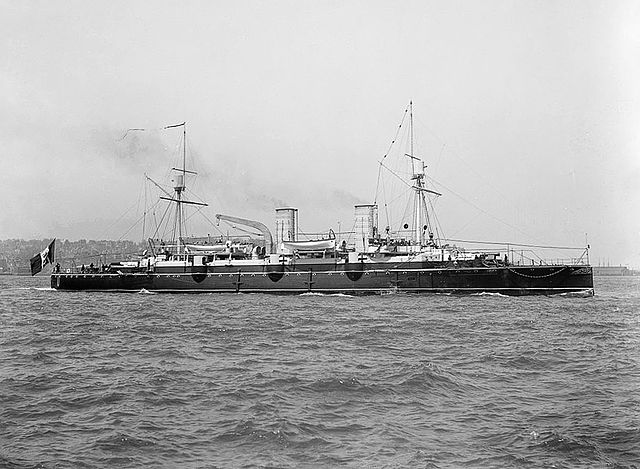
Giovanni Bausan (1883), a typical 1880s Elswick cruiser on which the Etna were based on.
Design
Ettore Fieramosca, was slightly longer than the others at 290 feet (88.4 m). For the others normal figures were 283 feet 6 inches between perpendiculars, 42 feet 6 inches in beam and 19 feet of draft.
They had been armed originally two 254 mm guns, six 152 mm, five 57 mm, five 37 mm, 1 Revolver cannon, 2 machine guns and two to three torpedo tubes. Propellers were fed by two horizontal compound steam engines and four double-ended cylindrical boilers. They could reach on trials 17–17.8 knots (31.5–33.0 km/h; 19.6–20.5 mph).
The original Armstrong 10-inch (254 mm), 30-caliber breech-loading guns had been mounted in barbettes (open turrets) fore and aft, as customary for the 1880s. So despite their size, these ships packed quite a punch, being capable of delivering 450-pound (200 kg) shells flying at a muzzle velocity of 2,060 ft/s (630 m/s).
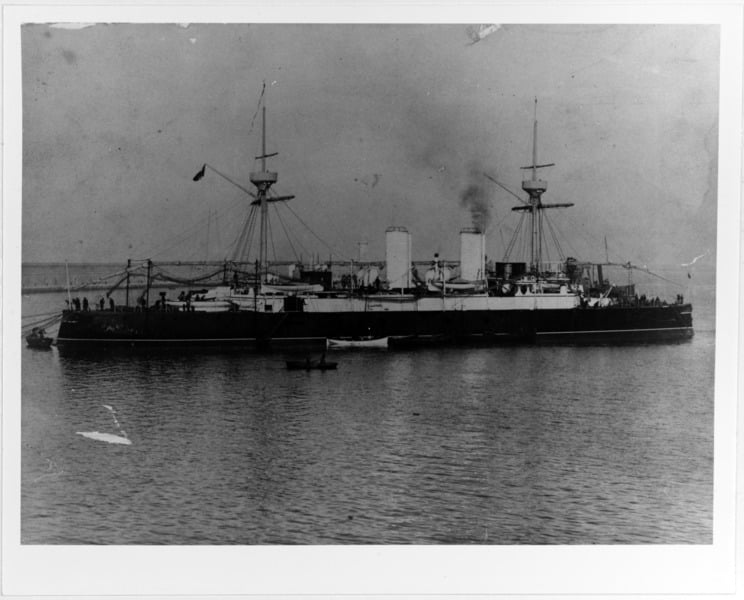
Ettore Fieramosca off Algiers
Secondary armament was mounted in Vavasseur mountings, in sponsons. The secondary anti-torpedo armament was quite comfortable with 6-pounder Hotchkiss guns firing at 6 rpm, completed by 1-pounder Hotchkiss guns (37 mm) at 30 rpm. The general disposition of the torpedo tubes were one mounted underwater in the bow and the other three were above water, but for the Ettore Fieramosca which dispensed of a TT.
Protection was interesting as they had an armoured belt with a maximum thickness of 1.5 inches (38 mm) doubled with an inner belt of cork at their waterline to absorb water if needed.
1900 Reconstruction
In 1900, they were rearmed with one 75 mm and 4 TTs, then in 1907-1909 (Not for the Stromboli and the Fieramosca, disarmed at these dates), their old 254 mm, two 152 mm were removed while two 120 mm guns were added. The remainder of her artillery were two 47 mm, two 37 mm and 2 TTs.
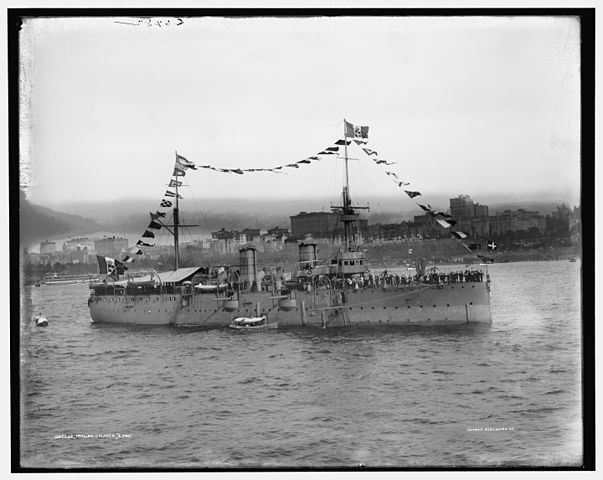
Etna as rebuilt, at the 1909 Hulton-Fulton Celebrations, Hudson bay, NYC
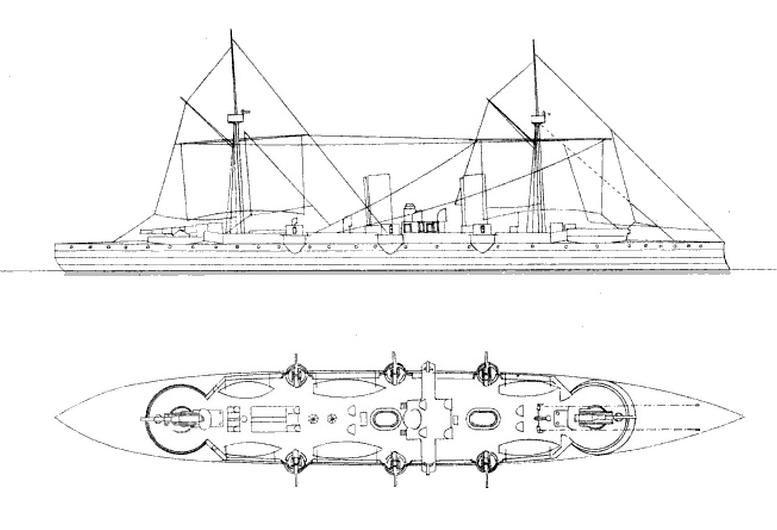
Line drawing of the Bausan. The Etna were very similar (after reconstruction)
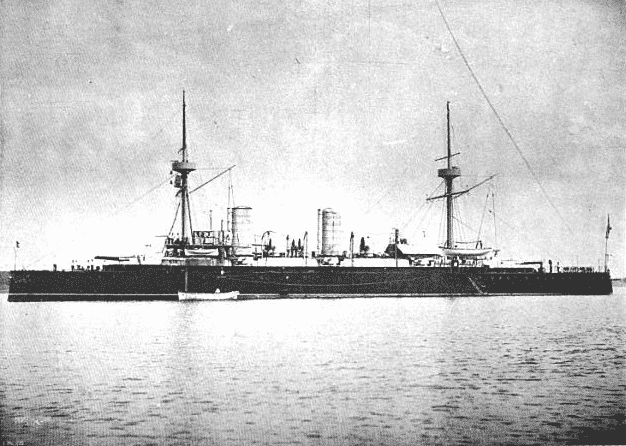
Italian protected cruiser Stromboli in 1895
Etna class cruisers specs |
|
| Dimensions | Length 91.4 m x 13.22 m x 5.8 m (283 x 42 x 19 ft) |
| Displacement | 3390 long tons, 3700 t FL |
| Crew | 321 |
| Propulsion | 2 shafts, two DE engines, 4 boilers, 7200 hp, |
| Speed | 17 knots (31.5 km/h; 19.6 mph) |
| Range | 5,000 nautical miles (9,300 km; 5,800 mi) at 10 knots |
| Armament (Etna 1914) | 2x 152 mm, 2× 120 mm, 2x 47mm, 2x 37mm, 2 TT 350 mm. |
| Armor | Belt armor: 38 mm, Barbettes 51 mm, Deck: 30 mm, blockhaus 13 mm |
Career
The ships had been laid down in 1884 respectively at Castellammare, Venice and Livorno shipyards. The Fieramosca was laid down in 1885 at Livorno. Launched in 1885-86, they were completed in 1887 (Etna), 1888 (Vesuvio, Stromboli), and 1889 (Fieramosca). The ships went into the Squadra Permamente (Permanent Squadron) up to 1893, visiting South and North America several times. Etna was in Red Sea (First Italo-Ethiopian War 1895–6) and the Cretan Revolt of 1898. She was also flagship of the Superior Torpedo-Boat Command in 1904.
The three other ships participated in putting down the Boxer Rebellion as part of the Eight-Nation Alliance. The Vesuvio was disarmed in 1911, before the first Balkan war, while Etna was converted into a training vessel and served as such from 1907 to 1914. At the time of the war, she was assigned as a coast guard after serving as a floating HQ, then a tanker and finally a GHQ for the entire Italian fleet in Taranto. She was only sold and broken up in 1921.
It should be noticed that there was a second, perhaps better-known Etna class on the Internet, which was one of a never-finished class of light cruisers (1941) originally built for the Thai Kingdom. There will be an article about these too.
Gallery
Illustration of Etna as rebuilt in 1914
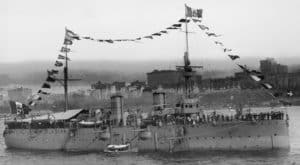
HD photo of the Etna on the Hudson Bay, 1909
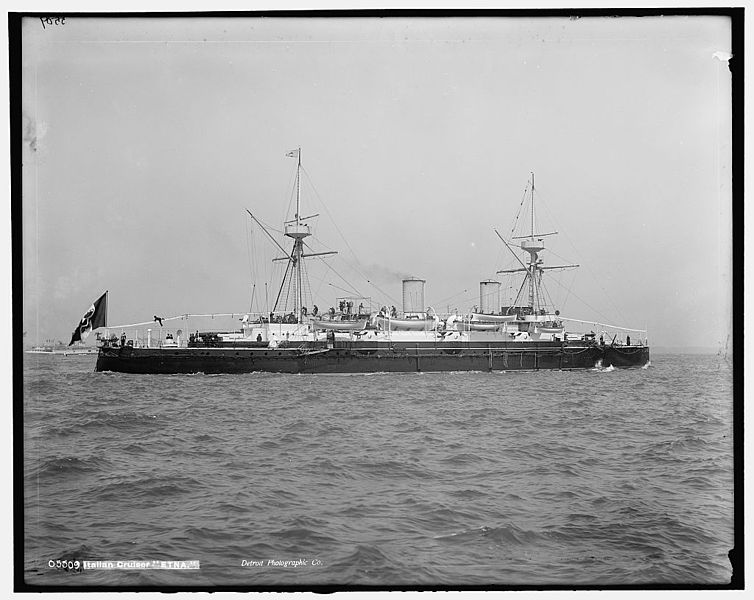
Italian cruiser Etna in its 1890s black, white and sand canvas livery
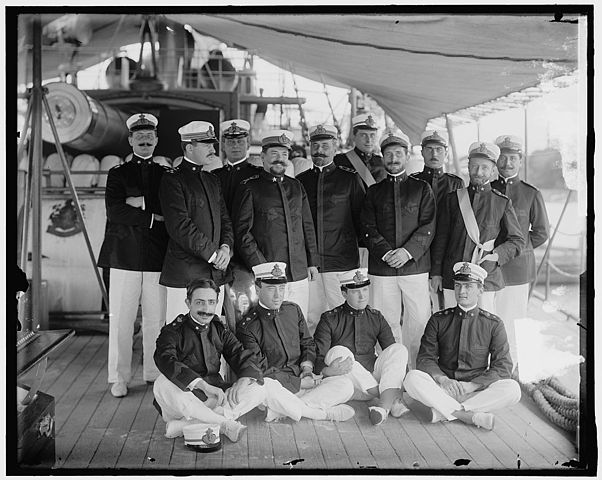
Ettore Fieramosca’s officers taking the pose
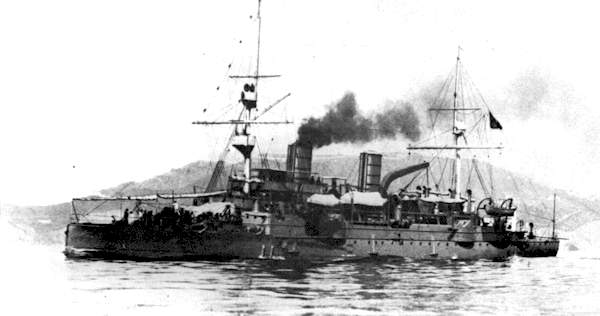
Cruiser Giovanni Bausan
Links
Etna class on Wikipedia
Specs Conway’s all the world fighting ships 1860-1905.
Note: Post scheduled for rewriting in 2026.


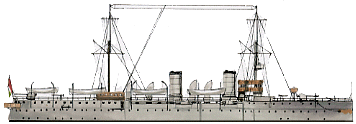
 Latest Facebook Entry -
Latest Facebook Entry -  X(Tweeter) Naval Encyclopedia's deck archive
X(Tweeter) Naval Encyclopedia's deck archive Instagram (@navalencyc)
Instagram (@navalencyc)





 French Navy
French Navy Royal Navy
Royal Navy Russian Navy
Russian Navy Armada Espanola
Armada Espanola Austrian Navy
Austrian Navy K.u.K. Kriegsmarine
K.u.K. Kriegsmarine Dansk Marine
Dansk Marine Nautiko Hellenon
Nautiko Hellenon Koninklije Marine 1870
Koninklije Marine 1870 Marinha do Brasil
Marinha do Brasil Osmanlı Donanması
Osmanlı Donanması Marina Do Peru
Marina Do Peru Marinha do Portugal
Marinha do Portugal Regia Marina 1870
Regia Marina 1870 Nihhon Kaigun 1870
Nihhon Kaigun 1870 Preußische Marine 1870
Preußische Marine 1870 Russkiy Flot 1870
Russkiy Flot 1870 Svenska marinen
Svenska marinen Søværnet
Søværnet Union Navy
Union Navy Confederate Navy
Confederate Navy Armada de Argentina
Armada de Argentina Imperial Chinese Navy
Imperial Chinese Navy Marinha do Portugal
Marinha do Portugal Mexico
Mexico Kaiserliche Marine
Kaiserliche Marine 1898 US Navy
1898 US Navy Sovietskiy Flot
Sovietskiy Flot Royal Canadian Navy
Royal Canadian Navy Royal Australian Navy
Royal Australian Navy RNZN Fleet
RNZN Fleet Chinese Navy 1937
Chinese Navy 1937 Kriegsmarine
Kriegsmarine Chilean Navy
Chilean Navy Danish Navy
Danish Navy Finnish Navy
Finnish Navy Hellenic Navy
Hellenic Navy Polish Navy
Polish Navy Romanian Navy
Romanian Navy Turkish Navy
Turkish Navy Royal Yugoslav Navy
Royal Yugoslav Navy Royal Thai Navy
Royal Thai Navy Minor Navies
Minor Navies Albania
Albania Austria
Austria Belgium
Belgium Columbia
Columbia Costa Rica
Costa Rica Cuba
Cuba Czechoslovakia
Czechoslovakia Dominican Republic
Dominican Republic Haiti
Haiti Hungary
Hungary Honduras
Honduras Estonia
Estonia Iceland
Iceland Eire
Eire Equador
Equador Iran
Iran Iraq
Iraq Latvia
Latvia Liberia
Liberia Lithuania
Lithuania Mandchukuo
Mandchukuo Morocco
Morocco Nicaragua
Nicaragua Persia
Persia San Salvador
San Salvador Sarawak
Sarawak Uruguay
Uruguay Venezuela
Venezuela Zanzibar
Zanzibar Warsaw Pact Navies
Warsaw Pact Navies Bulgaria
Bulgaria Hungary
Hungary

 Bundesmarine
Bundesmarine Dutch Navy
Dutch Navy Hellenic Navy
Hellenic Navy Marina Militare
Marina Militare Yugoslav Navy
Yugoslav Navy Chinese Navy
Chinese Navy Indian Navy
Indian Navy Indonesian Navy
Indonesian Navy JMSDF
JMSDF North Korean Navy
North Korean Navy Pakistani Navy
Pakistani Navy Philippines Navy
Philippines Navy ROKN
ROKN Rep. of Singapore Navy
Rep. of Singapore Navy Taiwanese Navy
Taiwanese Navy IDF Navy
IDF Navy Saudi Navy
Saudi Navy Royal New Zealand Navy
Royal New Zealand Navy Egyptian Navy
Egyptian Navy South African Navy
South African Navy






























 Ukrainian Navy
Ukrainian Navy dbodesign
dbodesign